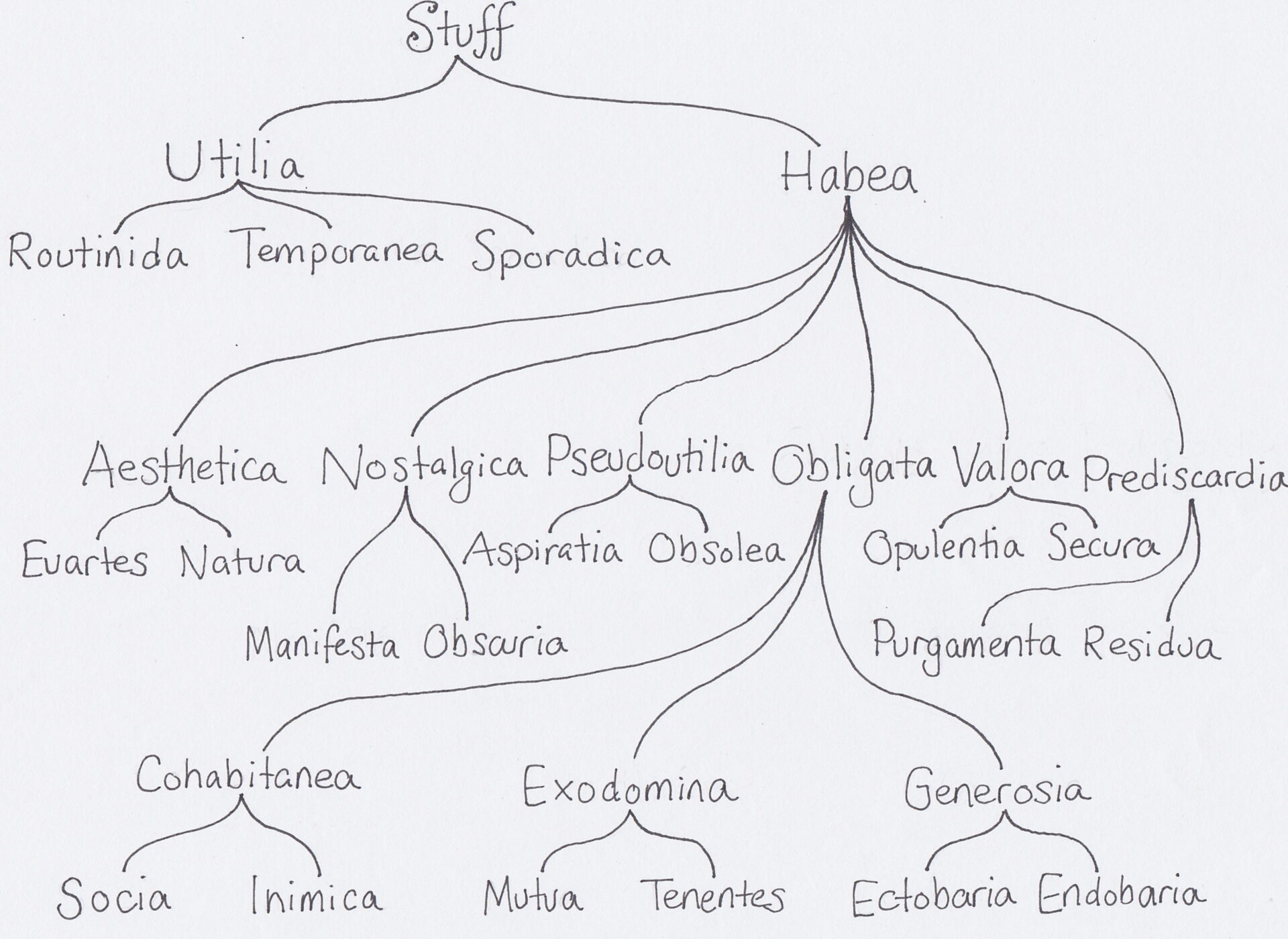By Amy Smift
[Published here by permission.]
[Note from Jed: For a taxonomic tree diagram, see the end of this page.]
This taxonomy is to be used to classify material items in the home. The defining principle is that classification is subjective and specific to one person living in that home; each household member makes their own classifications.
- Utilia: Things for using.
- Routinida: Things used on a regular basis, or frequently. Things you’d replace promptly if lost or broken.
- Temporanea: Things used regularly sometimes. Seasonal items.
- Sporadica: Things used occasionally. Some Sporadica like fire extinguishers and other emergency supplies may never be used, but would still definitely be used if their use case arose. Sporadica may also include supplies for planned upcoming events.
- Habea: Things for having.
- Aesthetica: Things kept for being pleasing or beautiful.
- Euartes: True art, things made as art.
- Natura: Natural objects like shells and rocks.
- Nostalgica.
- Manifesta: Things whose significance or meaning would be intelligible to others (for example, photo albums, diplomas, letters).
- Obscuria: Things whose significance would not be apparent without personal knowledge or memory (for example, playbills, souvenirs, books, toys, clothes).
- Pseudoutilia.
- Aspiratia: Things you aim to use, but haven’t yet and have no specific plan to use. Differentiated from Sporadica by having no external use trigger; use of Aspiratia would be internally prompted.
- Obsolea: Things you used to use, but are not going to use again. Many Obsolea resemble Sporadica and taxonomic differentiation may be challenging.
- Obligata: Things that someone else expects you to keep.
- Cohabitanea: Things that live with you but belong to someone else in the house.
- Socia: Friendly things you also use or like.
- Inimica: Enemy things you wish could go away.
- Exodomina: Things owned by someone outside the household.
- Mutua: Things you have borrowed but are done using.
- Tenentes: Things you are storing for someone else.
- Cohabitanea: Things that live with you but belong to someone else in the house.
- Generosia: Things received as gifts.
- Ectobaria: Things that there is an external pressure to keep, usually by the giver.
- Endobaria: Things that you feel an internal pressure to keep because of the giver.
- Aesthetica: Things kept for being pleasing or beautiful.
- Opulentia: Things displayed or shown off.
- Secura: Things held in private (hidden, locked up, or simply never displayed).
- Purgamenta: Routine garbage (trash/recycling/compost) waiting for scheduled departure.
- Residua: Things with some remaining value meant to be donated, sold, or given away.
Original hand-drawn taxonomy diagram, by Amy, showing the same relationships among the categories as indicated above in outline form:

Alternate horizontal-oriented taxonomy diagram, this one computer-generated; created by Jed (based on Amy’s version above), using Observable Plot to present the same information:
I’ve put another alternate diagram, this one also computer-generated but vertically oriented, on a separate page. This one, too, presents the same information, but it has collapsible nodes; you can click a node to hide its children.
(Both of my computer-generated diagrams were inspired by the phylogenetic trees shown in the game Metazooa. I asked the author of that game what tool was used for the diagrams, and he pointed me to D3, which led me to Observable Plot.)